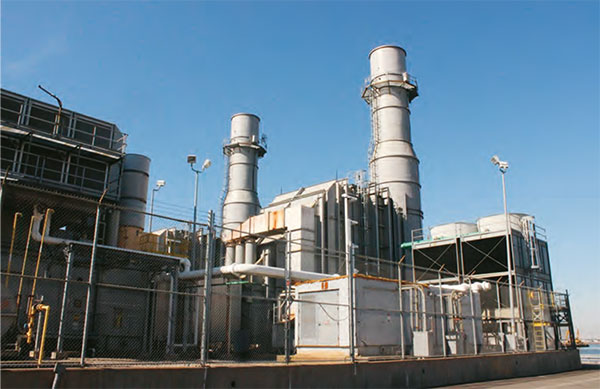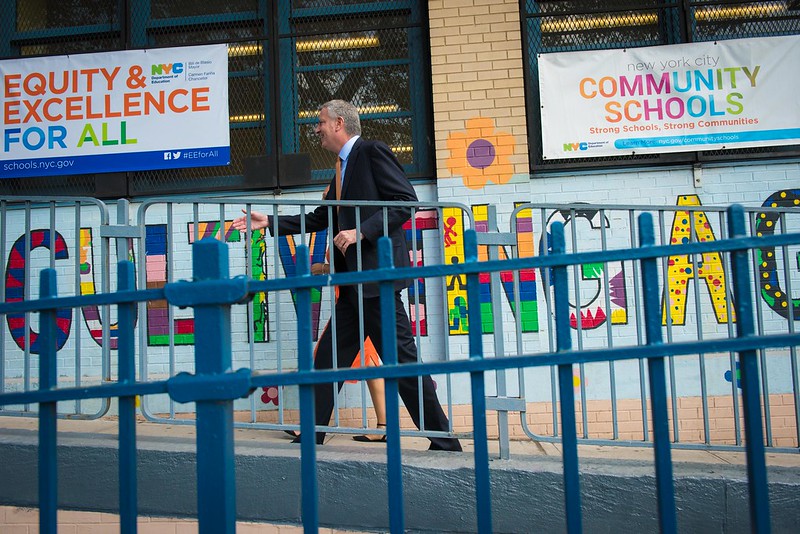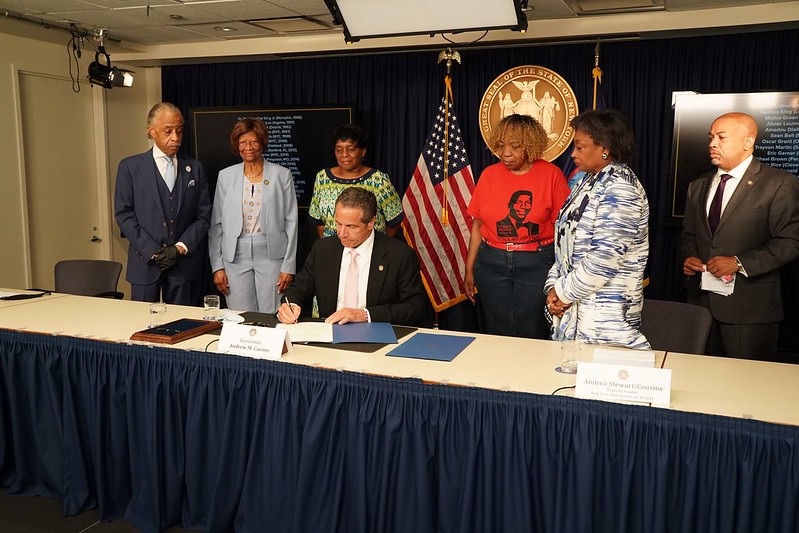Peaker Plants Harm Communities of Color; It’s Time for New York City to Replace Them

A peaker plant
As the weather warms and we head into the summer, we again expect record-breaking temperatures. Thousands of New Yorkers worry about accessing air conditioning units and surviving a hot summer in cramped apartments, and many will struggle to balance higher electricity bills from air conditioning against costs of health care, food, and rent. But most people don’t worry about the increased electricity demand from widespread air conditioning use during hot days and heat waves.
Most New Yorkers are unlikely to know about the polluting power plants located primarily in communities of color and low-income communities like the South Bronx and Sunset Park that fire up to meet peak electricity demand in New York City when millions of air conditioning units are running.
These half-century-old fossil fuel power plants, known as “peaker plants,” spew high levels of fine particulate matter and nitrogen oxides into the air in communities already burdened with other polluting facilities such as solid waste transfer stations and crowded truck routes. On the hottest days of the year, when air quality is already poor, turning up the air conditioner in Manhattan can mean even more air pollution in environmental justice communities like Sunset Park, Mott Haven, and Hunts Point, where childhood asthma rates are more than double other areas in the Bronx.
New research closely links chronic exposure to higher levels of air pollution such as fine particulate matter and nitrogen oxides to higher mortality rates from COVID-19. Long-term exposure to high levels of air pollution, along with extreme heat, subject already vulnerable communities to greater rates of hospitalization and death from climate events. Health disparities are exceptionally prevalent in neighborhoods like Sunset Park where 22% of the community does not have access to health coverage.
New York City must update the current polluting, inefficient, and inequitable energy system for meeting peak electricity demand in order to reduce pollution and protect health in vulnerable communities, enhance community resiliency, and create green jobs.
New York City’s peaker plants are a prime example of environmental discrimination: the disproportionate burden of pollution and environmental health hazards inflicted on communities of color. Studies have shown that Black and Latino communities across the United States suffer disproportionate levels of air pollution, even as the most privileged are disproportionately responsible for the consumption of goods and services that generate this pollution. Neighborhoods like Hunts Point and Mott Haven in the South Bronx rank highest on the city’s heat vulnerability index, but have one of the lowest shares of air conditioner ownership in the city. These neighborhoods are home to four peaker plant turbines that run among the most frequently of all the city’s 16 peaker plants – often on hot, poor air quality days.
Pollution isn’t the only problem with peaker plants. As revealed in a report released this month by the newly formed PEAK Coalition, peaker plants are a huge expense for electricity customers. Over the past decade, the city’s peaker plants have cost city residents approximately $4.5 billion in electricity bill payments. And this price tag isn’t even for use of the peaker plants – it’s simply the cost of having the peaker plants sit around, available for use in case they’re needed on those peak-demand days. Most of the money has gone to private, out-of-state companies that own the oldest and most polluting plants in the city’s peaker fleet. Spending billions of dollars going forward to prop up the use of antiquated fossil fuel power plants with few to no pollution controls makes no sense.
The solution isn’t for New Yorkers to stop using air conditioning or to feel guilty about it – access to adequate cooling during dangerously high heat days should be a human right, not a privilege. The city must update the current polluting, archaic, and inefficient system for meeting peak electricity demand and replace fossil fuel peaker plants by investing in energy efficiency upgrades, large-scale renewable energy generation and battery storage, and distributed smaller-scale renewable energy generation and storage. Renewable energy and storage will not only reduce air pollution but can also enhance community resiliency in the face of storms or blackouts and create green, local jobs and workforce training opportunities.
Under New York’s groundbreaking climate law passed last year, the Climate Leadership and Community Protection Act, the state must reform this system to achieve a carbon-free electricity generation system by 2040. But there is no need to wait that long – the technology exists to transform the system. We just need a commitment to prioritize the health and resilience of our neighborhoods. Communities like the South Bronx and Sunset Park, among the hardest-hit in the current pandemic, can’t afford to wait another 20 years to reduce air pollution.
***
Rachel Spector is Director of Environmental Justice at New York Lawyers for the Public Interest; Elizabeth Yeampierre is Executive Director at UPROSE; and Dariella Rodriguez is Director of Community Development at The Point CDC. All three are members of the PEAK Coalition. On Twitter @NYLPI & @UPROSE & @THEPOINTCDC.
***
Have an op-ed idea or submission for Gotham Gazette? Email This email address is being protected from spambots. You need JavaScript enabled to view it.
The Mayor’s Short-Sighted Professional Development Design

Mayor de Blasio goes to school (photo: Michael Appleton/Mayor's Office)
It was 2014 when Mayor de Blasio declared that “under Carmen Fariña’s leadership, principals and teachers alike have been training and training and training – it’s like they’re all going to the Olympics – they’ve been training all summer to be the best they could be.”
But six years later, the mayor has changed his tune. He’s proposing to slash funding for professional development for the city’s 75,000 educators at a time when children need us most and teachers most need it to serve students in an unprecedented, quickly-changing environment.
Our city is weathering a devastating global pandemic, a transition to remote learning for 1.1 million kids, Great Depression-level unemployment, and corresponding city budget challenges – all as the nation has been shaken to its core by the death of George Floyd.
Amidst these simultaneous crises, kids are looking to teachers to understand this unique moment in history. And yet, despite the Department of Education touting professional development as central to child development over the last six years, educators everywhere are now on the cusp of a massive cut to the training they need.
It’s exactly the wrong thing to do at exactly the wrong time.
Today, of the Department of Education’s $25 billion budget, roughly $500 million goes towards teacher professional development. Now, as it faces a budget shortfall, City Hall plans to cut $67 million of PD – a significant scale-back. Investments in educators are one of the first things on the chopping block.
But the fact is learning should never stop, neither for our kids nor the adults who teach them. Pedagogical mastery is a long-term progression, and halting that mastery during a time of crisis will be felt in classrooms everywhere, especially in the virtual learning age.
Why? Because, at this moment, teachers are being asked to reinvent decades of practice practically overnight, all behind a computer. They’re doing things they’ve never had to do before. With schools expected to adopt a hybrid model of in-person and remote instruction in the fall, virtual classrooms will be with us for months to come.
That means our students will be even more vulnerable if their teachers don’t have the resources to effectively instruct remotely. Learning loss could be catastrophic, and our health crisis could indeed morph into a long-term learning emergency for our city.
We know the antidote, though. It’s investing in teachers. Doubling down on training for educators, especially if officials tailor it for the moment in which we’re living, is not some isolated line item. It’s a deliberate strategy for success.
At my school – Bronx Charter School for the Arts – roughly 82% percent of our elementary students are attending virtual class each day, and professional development has been a key ingredient to our success. Once we overcame the initial challenge of providing devices to students, adapting our lessons to a remote environment was the next hurdle, especially for reading and literacy.
Our curriculum, Units of Study, cultivates collaboration and socialization, while fostering independence. Children analyze characters, develop critical thinking skills, and grasp the big picture of story elements. Those objectives are hard to achieve virtually, but we’ve been reflective practitioners, balancing the needs of the students and our programmatic goals. Working closely with our curricular experts at the Teachers College Reading and Writing Project, we have often revised the work to be responsive. Constant teacher training, and having quality curricular partners, has made distance learning merely a new skill that we’ve mastered – not a permanent roadblock to learning.
Our professional development partners themselves have also pivoted their own programs to meet this moment. The Reading and Writing Project recently ran a virtual Pandemic Institute, which provides lesson plans for teachers that allow their students to become historians of this crisis. Enabling children to make connections between their current day-to-day experiences and their learning is one of the main reasons our attendance numbers are so high.
And at this moment, perhaps more than any other in recent memory, connecting learning to real-time events is critical.
That’s also why cutting professional development citywide is so short-sighted. As a school leader, I recognize the difficult decisions our city leaders have to make right now. But I also know that we don’t want to create long-term pain for a short-term gain. We’ve instructed all of our children to focus on their education. But if teachers do not continue to grow their craft through professional development – especially during these trying times – then policymakers are acting in the opposite manner for which we have advised students all of their young lives.
Teachers are doing heroic work right now, and we need to set them up for continued success.
***
Jonea Thomas is the elementary school principal at Bronx Charter School for the Arts.
***
Have an op-ed idea or submission for Gotham Gazette? Email This email address is being protected from spambots. You need JavaScript enabled to view it.
Life and Death at the Stroke of the Governor's Pen

Governor Cuomo signs criminal justice reforms (photo: Governor's Office)
New York Governor Andrew Cuomo has been trying in his daily press briefings to position himself as the national voice of reason, truth, and compassion regarding the coronavirus. To that end, he has liberally signed an array of executive orders ranging from shutting down businesses and closing schools to limiting the size of social gatherings.
When the evidence revealed that COVID-19 was especially ravaging communities of color, the governor then tried to assume the mantle of race truth-teller by referring to the persistence and pervasiveness of racism in vital areas like housing, education, health, and employment. He even began to use visual aids to show that specific zip codes -- communities of color -- were hardest hit by the virus.
George Floyd’s murder by the police and the resulting uprisings across the country pushed COVID-19 out of the headlines. Not to be outdone, and to maintain his newfound national relevance, the governor started trying to use his bully pulpit to project himself as the voice of anti-racist criminal justice reformers. He quickly seized upon the calls to repeal Civil Rights Law 50-a that shielded police disciplinary records from the public. He appeared to have heard the community activists and families of loved ones killed by police who had for many years labored relentlessly for the repeal of 50-a. Now, with the national spotlight on police violence, the governor gave full-throated support to their efforts as if he were a long-time ally of the movement. He proclaimed, “I would sign a bill today that reforms 50-a. I would sign it today. Pass the bill. I will sign it today.”
Soon thereafter, the Legislature did send him such a bill as part of a criminal justice reform package, and with great fanfare the governor signed it, calling it the “most aggressive” police reform legislation in the country. He also used the occasion to condemn “injustice against minorities in America by the criminal justice system" and emphatically added, “Today...enough is enough.”
The governor was not yet finished signing criminal law reforms. In his effort to be seen as a national progressive spokesperson regarding police violence against people of color, he announced that he had signed an executive order making state funding to police agencies contingent on their developing plans to “reinvent and modernize” their strategies. A few days later, he again put pen to paper and signed additional criminal law legislation asserting that the changes “take us one step closer to righting the many injustices minority communities have faced because of a broken and unfair system."
All well and good but if the governor truly believes that “enough is enough” then he must use his signature to redress the crisis of mass incarceration and the 40,000 people in his state prisons: the living embodiment of the “injustice against minorities in America by the criminal justice system."
The racism that defines the criminal legal system does not stop with racist policing. It runs through arrest, prosecution, adjudication, and sentencing. It results in more than 9,000 people, disproportionately people of color, serving life sentences in New York State. And many come from the very zip codes the governor highlights daily in his visual aid of the “hot spots” for coronavirus in New York.
There are thousands of clemency applications on the governor’s desk from people seeking sentence commutations. The majority are from people of color. In 2019, Cuomo did not sign a single one.
Many meritorious clemency applications pre-date COVID-19. Now, for those most at-risk from the virus, the specter of serious medical complications or death adds even more weight to their applications. The governor has repeatedly stressed the danger facing vulnerable people living in congregate spaces. While he specifically refers to nursing homes, even he has made the irrefutable connection to prisons: “It’s the same with the nursing home, it’s a prison, it’s any congregate facility. There’s no doubt, where you have a congregation of people, that is a place where the virus can transfer...So, the congregate facilities of people, that’s all it is. It’s just wherever you have a density, a gathering of people that is a problematic area...”
Yet to date, amid all his signing ceremonies, he has signed zero clemency applications from the many older and ill people pleading for relief.
Incarcerated people and their families live in fear that COVID-19 will ravage the prisons where already more than 1,800 prison staff and people inside have contracted the virus and 21 have died. For many, there is newfound hope that the governor’s talk about the racism and injustice in the criminal legal system will lead him to finally exercise his vast clemency power.
Countless number of clemency applicants have worked hard to improve and transform and have achieved dramatic success under the trying and unforgiving circumstances of prison. Most have already served decades behind bars. In the governor’s own words, “Enough is enough.” Now all that is needed to set them free is his signature.
****
Steven Zeidman is a professor of law at CUNY School of Law. On Twitter @SteveZeidman.
***
Have an op-ed idea or submission for Gotham Gazette? Email This email address is being protected from spambots. You need JavaScript enabled to view it.




